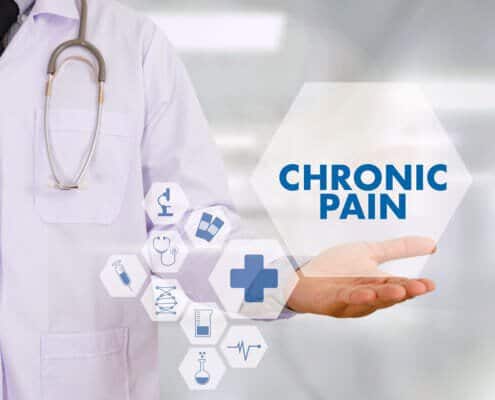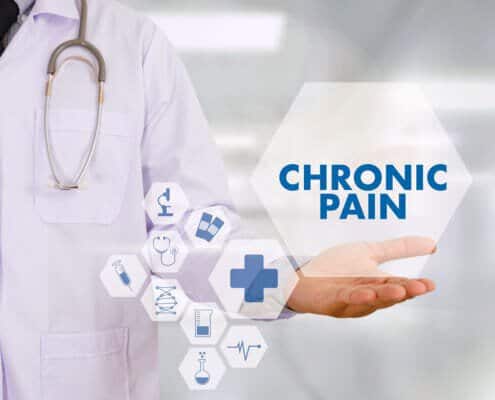
Occasional aches and pain is a part of everyone’s life. The fact is, pain is one of the most vital nervous system responses that alerts the body to potential injury. When you are injured, the pain signals are sent directly to the brain via your spinal cord.As the injury heals, the amount of pain is reduced. However, it is not the same case with chronic pain.
It is very different from the typical pain and can take a major toll on all the important aspects of your life. When experiencing chronic pain, your body keeps on sending pain signals to the brain even after the injury is completely healed. And, this can last for weeks, months, and even years. Eventually, it can hamper your strength, functionality, mobility, and endurance, making it extremely difficult to carry out even the basic everyday tasks.
Generally, the pain that lasts for a minimum of 12 weeks is called chronic pain. Patients may experience intense or dull pain along with aching and burning sensations in the affected areas. This pain can be intermittent or steady, coming and disappearing without any solid reason. Any part of the body can experience chronic pain; however, the feeling of pain can be different for various areas.
Common Types of Chronic Pain
- Arthritis pain
- Postsurgical pain
- Cancer pain
- Headache
- Psychogenic pain
- Trauma pain
- Neurogenic pain
- Lower back pain
- Post-surgical pain
According to a report from the American Academy of Pain Medicine, chronic pain has targeted over 1.5 billion people around the world and it is one of the most prevalent causes of disability in the United States of America. Around 100 million people in the US are affected by chronic pain.
Common Causes of Chronic Pain
Initial injuries such as pulled muscles or sprain can lead to massive pain. Health care experts suggest that damaged nerves develop pain and the severity of the damage decides if the pain is dull, intense, or long-lasting. In most such cases, treatments for the underlying injuries fail to get rid of chronic pain.
On the other hand, some cases of chronic pain do not necessarily arise because of any prior injury. And, the knowledge on the exact causes behind this type of chronic pain is limited. According to medical experts, such pain can be the result of an existing health condition such as the following:
- Inflammatory bowel disease (IBD): This causes chronic inflammation and pain in the digestive tract.
- Temporomandibular joint dysfunction (TMJ): This causes locking, popping, and clicking in the jaw with pain.
- Chronic fatigue syndrome: Prolonged weariness can cause this condition and it often comes with massive pain.
- Fibromyalgia: This leads to extensive pain in muscles and bones.
- Interstitial cystitis: This occurs to pain and bladder pressure.
- Vulvodynia: This is no exact reason. However, it results in pain in the chronic vulva.
- Endometriosis: It occurs due to the growth of uterine linings outside the uterus.
Who Is At The Risk of Chronic Pain?
While anyone can be affected by chronic pain, older people are more vulnerable to it. Apart from age, there are several other factors that can put you at risk of chronic pain such as:
- Injury
- Obesity
- Being underweight
- Being female
- Surgery
What Are The Treatments For Chronic Pain?
No matter what treatment plan you are kept on, the goal of all is the same — to enhance your body’s functionality so that you can perform everyday tasks without any challenge.
The severity of this pain differs from person to person and this is why pain experts often develop a unique treatment plan for all the patients. Such plans are designed in a way to satisfy the needs of the individuals and may include therapies, medications, lifestyle changes, or a combination of these.
Medical Procedures For Chronic Pain
- Surgery
- Nerve block
- Acupuncture
- Electrical stimulation
Medications For Chronic Pain
- Acetaminophen (Tylenol)
- Aspirin (Bufferin)
- Ibuprofen (Advil)
- Morphine (MS Contin)
- Codeine
- Hydrocodone (Tussigon)
- Antidepressants
- Anticonvulsants

Lifestyle Changes For Chronic Pain Relief
- Psychotherapy
- Art and music therapy
- Physical therapy
- Meditation
- Massage
- Pet therapy
- Yoga
- Tai Chi
It is not a secret that chronic does not have a permanent cure. However, it can be definitely managed with the help of the above-mentioned treatments. Patients must stick to their unique treatment plan to make the most of it.
There is a very thin line between physical pain and emotional pain. Therefore, chronic pain patients are more likely to fall victim to stress, anxiety, depression, and more. It is crucial to work on building strong emotional skills to adjust to the pain related to your particular condition. You can follow the below-mentioned steps in order to take care of your emotional state and reduce the stress:
- Be a part of your everyday routine
- Ask for help from medical experts, family, friends, etc.
- Eat healthily
- Exercise regularly
- Get proper sleep
The Role of Mediation In Chronic Pain Treatment
Despite having world-class laboratories and advanced technologies, the world of medicine still considers chronic pain as an unresolved issue. This is because finding the exact answer to this problem is difficult due to thousands of signalling pathways and numerous mechanisms that give birth to chronic pain.
The most common mechanism of this pain is inflammation that takes place in the affected areas. Inflammation leads to the release of immunoreactive and proinflammatory substances like chemokines, neurotrophic factors, and cytokines. This causes local actions in the site of an injury that leads to increased generalized immune response.
Due to the limited research and understanding of various cellular mechanisms and how they trigger and maintain chronic pain, clinical management of this disease is highly complicated.
Things such as immune responses. Genetic factors, inflammation, endocrine and nerve system have a lot to do with chronic pain. These are nothing but the mediators of chronic pain.
Various neurotransmitter-receptor systems can lead to modulation of pain transmission, especially those that hamper the spinal processing of nociceptive input. Main excitatory neurotransmitters such as substance P are present in our spinal cord and they can improve pain transmission. On the other hand, endogenous transmitters work on dorsal horn neurons and lead to the release of excitatory transmitters and eventually, decreasing pain and the perception of the body towards it. An example of the endogenous transmitter is analgesics that are exogenously administered.
Nociceptors are generally known as pain receptors and their stimulation can result in pain. They are located in three major parts of the body — visceral structures, musculoskeletal, and skin. Our body takes voluntary actions to indicate the perception of pain. Chemical mediators are a crucial part of this process as they provide the target of pharmacological modulation.
Here is the list of different pain mediators that are included in this process:
- Potassium and proteolytic enzymes
- Serotonin
- Histamine
- Tissue kininogens (bradykinin)
- Eicosanoids (e.g., prostaglandins, leukotrienes)
- Substance P
- Vasoactive intestinal peptide (VIP)
- Endorphin / enkephalin
- Angiotensin II
- Brain opioids
- Catecholamines
- Oxytocin
- Vasopressin
- Glucocorticoids
- Adrenocorticotropic hormone (ACTH)
Apart from producing hypertension in chronic pain patients, Bradykinin results in vasodilatation and enhances vascular permeability. Moreover, it causes pain and marginalization of leukocytes in the patient’s blood vessels.
Pro-inflammatory Effects of Substance P
As mentioned earlier, substance P is one of the excitatory neurotransmitters. It may leave the following effects:
- Increase in the production of inflammatory mediators
- Release of inflammatory mediators
- Leucocytes chemoattractant and proliferation
- Mast cell degranulation
- Release of histamine
- Release of cytokines
The released histamine is collected in the mast cells. Then, substances like IgE activate the mast cells and release histamine. This results in immediate hypersensitivity reactions. Interactions with particular receptors cause mediation of a number of effects of histamine.
On the other hand, another chemical mediator, serotonin is stored in granules of platelets. It plays a major role in the descendent inhibiting pathways.
Prostaglandins are another pain mediator that supports the development of pain and oedema. Even though they do not induce inflammatory symptoms, they activate specific sensitive nerves and receptors in the blood vessels.
When released, endogenous opioids (also known as opium peptins) offer analgesia. However, the release of this should occur at high concentrations in specific encephalic regions. Some examples of such endogenous opioids are — endorphin, dynorphin, and enkephalin.

Final Words
Being one of the major causes of chronic pain in most cases, inflammation is the result of the release of several above-mentioned chemical mediators. This release can be from the inflammatory cells or injured tissues. The level and intensity of this inflammation process often decide the severity and type of pain.
Furthermore, several other factors such as drugs, stress, anxiety, blood pressure, attention, expectation, the emotional state can regulate pain. This possibly happens due to the activation of analgesic systems. Certain things such as effective drug administration, behavioral manipulation, and environmental manipulation can alleviate the pain, or at least reduce the pain intensity.
However, it is highly important to understand the type of chronic pain and its origin before setting up a treatment plan. Remember that not all chronic pain types need medication and certain lifestyle remedies and therapies can be effective in such cases.




